| Key Takeaways |
|---|
| Understand the pop structure: Pop songs typically follow a predictable structure. It usually includes the verse, pre-chorus, chorus, and bridge. |
| Create catchy melodies: Pop songs are known for their memorable melodies. Experiment with different notes and rhythms until you find a melody that sticks. |
| Write relatable lyrics: Successful pop songs often have lyrics that are universal and relatable. Aim to capture a specific emotion or scenario that your listeners can connect with. |
| Use hooks: Hooks are catchy parts of a song that catch the listener’s ear and make the song memorable. This could be a musical phrase or a catchy chorus. |
| Production and arrangement: Ensure your song’s production values and arrangements are as polished as possible. Using appropriate instrumentation, background vocals, and sound effects can significantly enhance the appeal of your song. |
Writing Pop Music
Pop music is a very broad term; technically, it means music that’s popular. But there is definitely a sound to this genre that is distinct.
In more modern times, you can typically expect a solid beat, bouncing bass lines, 80s-style synths, and a highly infectious vocal melody. Of course, there are always exceptions, and there are definitely more varied elements for different artists.
It may seem daunting to create a polished, bright, and catchy Pop song, but there are some tips that we can share with you to help you along the way.
In this article, I will be discussing the structure of a Pop song, the chord progressions often found in this genre, and a detailed look at each instrument group that could be within a pop song.

Writing A Pop Song
First, let’s look at the musical elements of writing a Pop song. I group these elements based on their function in the song rather than the types of instruments involved. I have six categories for the different musical components of a song.
- Drums – contain all rhythmic aspects of the song, from kick drums to loops, all the way to little percussion sounds.
- Bass – contains all of the low-end parts of the track, such as bass synths, 808s, and bass guitar.
- Chords – contain all of the harmonic content. The elements that are playing or contributing to the chord progression.
- Lead – contains any melodic parts, whether it’s a background lead or a prominent lead.
- FX – contains all of the risers, impacts, and any noise or soundscapes adding texture to the song.
- Vocals – contains all of the vocal parts for the song and any prominent samples. Background vocal chops and samples will go to the lead group.
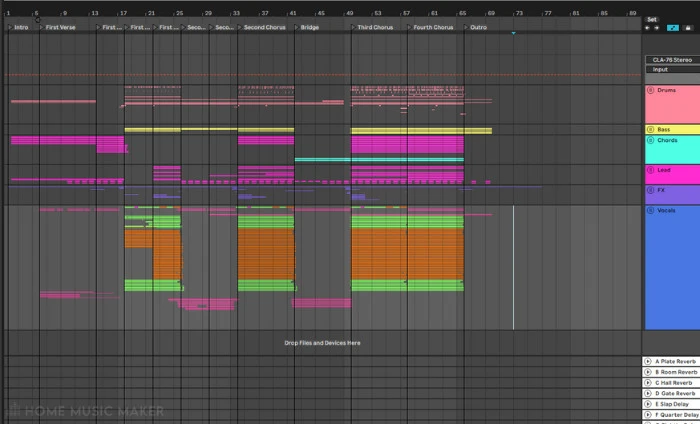
Drums
The beat of a pop song is usually quite simple. You often hear a four-on-the-floor kick drum pattern, which is a kick drum on every beat of the bar. However, Pop drums often borrow from other genres like Hip-Hop and use more interesting kick patterns. It all depends on the vibe you’re going for.
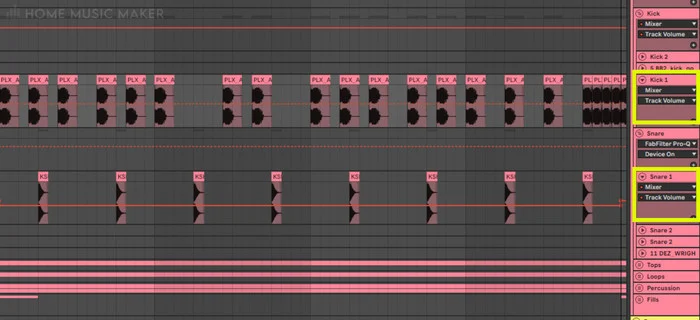
Placing a snare drum on the second and fourth beat is also pretty standard. Then using hi-hats on each eighth-note or sixteenth-note will round out the backbone of your beat nicely.
Now, just because it’s a simple beat doesn’t mean that you are done here. Pop music often contains extra elements in the drums to add more life and variation to the song. Varying the hi-hats more and adding an extra snare for certain sections is a great place to start.
Utilizing percussion loops can also add a more human element to the beat and add to the bounce. I typically add extra percussion as the song builds to subtly introduce new rhythms and evolve the song. With the further addition of fills, you can create a unique rhythm section for the song.
The critical thing to take away from this is variation. If everything is the same all the time, it will get boring. Even being subtle with changes will change the sonic texture of your music and keep it flowing.
Bass
The bass elements of a Pop song, just as in most other music genres, are the glue connecting the melodic and harmonic content to the rhythmic content. But it doesn’t end there.
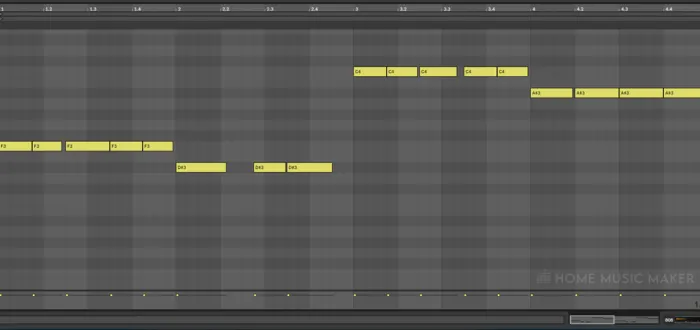
In Pop music, the bass also has become a focal point of the song. Whether this is for a specific section or the whole song, it’s essential to have a catchy bass line that still holds the song together.
Pop music these days borrows from Hip-Hop and Pop music from the 80s, and the bass sounds in Pop music today are no exception.
Combining 808s and synth bass is essential in creating a modern Pop song with hard-hitting, full bass parts with that 80s nostalgia. Something that is genuinely catchy but also hits hard.
Typically you will hear that many bass parts follow the kick drum pattern. This isn’t always the case, but it is a great place to start if your kick drum pattern is more complex than the four-on-the-floor beat I described earlier.
Your bass line should complement all the other parts in the song but also be able to stand out in certain moments and have catchy elements.
Chords
Start by choosing a chord progression that fits the mood and style of your song. A chord progression is simply a series of chords played in a specific order.
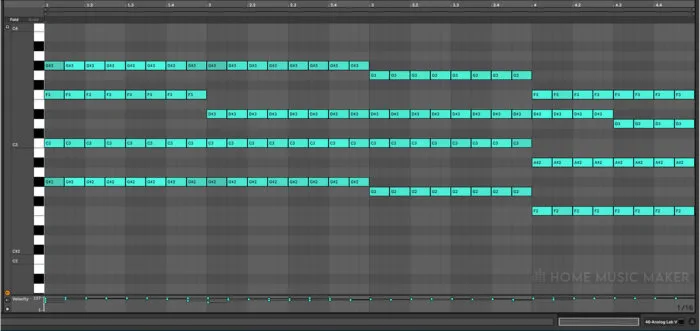
Many common chord progressions are used in Pop music, such as the I-IV-V or VI-IV-I-V progression. Experiment with different progressions until you find one that works for your song.
The way the melody is felt will change based on the chord progression. Find the chords that give the melody the emotional and harmonic backdrop you aim for in this song.
When choosing sounds for your chords, there are quite a few options. In modern Pop music, using synths, piano, and/or guitar is very common. For synths, you typically hear a lot of vintage synths, or at least emulations of them, such as the JUNO 106 or the Prophet V.
When it comes to using a piano in Pop music, it’s often very bright and not as full sounding as a piano actually is. This is both a stylistic choice, and there are already prominent bass parts in the song, so having the piano also in the low-end frequencies can overwhelm that frequency range of the song.
For guitar, it will most likely be a clean sound with moderate compression, maybe some modulation effect (such as chorus), and some spacial effects (such as reverb and delay).
Lead Instrumentation
The lead instrumentation group contains the melodies of the track that aren’t the vocals. I split the lead instrumentation into two groups, primarily for mixing purposes: background leads and leads.
The leads subgroup is all of the prominent instrumental melodies in the song. As you may have guessed, the background leads subgroup is for all the melodies that aren’t as forward in the mix and add more to the texture than the song’s main elements.
Leads
These elements will be catchy and memorable for our main lead instruments during parts with vocals and without. This can be a synth melody, a guitar melody, or anything. It must be catchy, add to the song, and sonically make sense with the instrumentation.
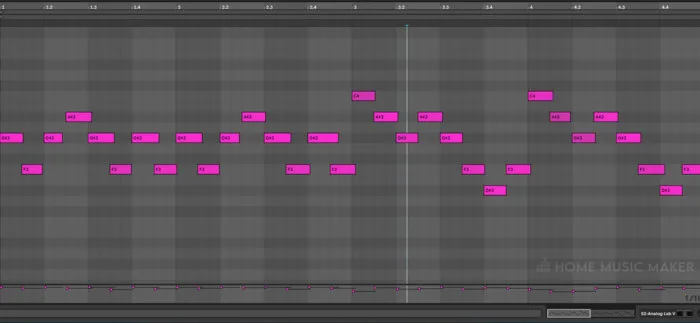
Often you will find that in Pop music, the lead melodies played on instruments are the same melody as the chorus or at least a variation. Other times, it tends to be a simple but memorable hook that elevates the song.
If you’re stuck, try humming melodies to your music and see what comes up. It will likely be exceedingly catchy if it’s easy to sing along to.
Background Leads
These elements add to the track’s overall sonic texture or serve as ear candy. Ear candy refers to sounds that shortly appear in music and add a nice bit of variation and personality to a song.
Typically these parts interact with the chords in the sense that they add to the harmonic content of the song. They are also great for evolving the song.
A way that I love to use background leads is to introduce them halfway through a verse to add variation and new textures and progress the song further. I also will add background melodies into the chorus to make it sound bigger for more impact.
You can get away with a weird combination of sounds here; it just has to fit. Experiment with different instruments and software synths, as a combination of two completely odd sounds could be the thing your song is missing.
FX
The FX elements in a song are typically rather subtle, but their effect is anything but. I have three subgroups within my FX group. These are textures, risers, and impacts.
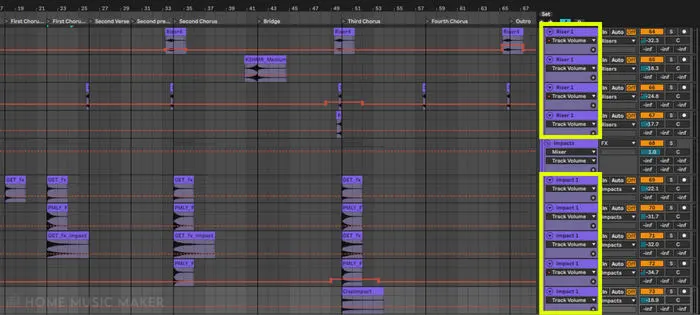
Textures include sounds like city noise, vinyl hiss, and nature soundscapes. These can be a prominent part of the song in certain sections to create an atmosphere that relates to the lyrics, or they can be placed throughout the whole song but for a certain vibe or subtle sonic texture.
Risers are sounds that literally sound like they are rising. You can get noise risers, which sound like something is being sucked up. There are synth risers, drum risers, and so much more. They are a great way to build up to a moment or even before a gentle release.
Finally, impacts are the sounds that usually follow risers. These can be anything from a gunshot to a finger snap. It depends on what section of the song you’re using them in. For a chorus, impacts release tension and make that big moment much bigger. For softer parts, they are used as a subtle transition.
Vocals
We can’t talk about vocals without talking about hooks.
A hook is a catchy melody or phrase that grabs the listener’s attention and sticks in their head. It’s often the most memorable part of a song.

Try to develop a hook that is simple, repetitive, and easy to sing along to. It should be something that people will remember long after they’ve heard the song.
Typically the hook will also be sung at a higher pitch than the verses, as the intensity is heightened and the energy is up. Think about how you want this song to make people feel.
A catchy hook is one thing, but a catchy hook that evokes a particular emotion is compelling.
Of course, don’t limit your catchy melodies to being only for the chorus. You can have different hooks throughout the song. Having these throughout the song makes your song more memorable and makes people want to listen to the whole song rather than the one catchy part.
For a great example of a catchy Pop hook, listen to still feel by half alive. It’s repetitive but not annoying. It is memorable and makes you want to sing along—all great qualities of a fantastic vocal hook.
If you keep this in mind while writing your vocal melodies, you’ll be onto a memorable song. If it gets stuck in your head, then chances are it will get stuck in other people’s heads.
READ NEXT:
Something that always sparks creativity for me is using a new piece of equipment or plug-in. We can’t constantly buy new things for this, but we can take advantage of free plug-ins. Check out our guide on the best free VST plug-ins for 2023.
Lyrics
When writing a Pop song, the lyrics are as important as the melody. They connect the listener to the song and convey the artist’s message. Here are some tips for writing compelling lyrics:
Theme And Message
Before you start writing, think about the theme and message you want to convey in your song. What is the story you want to tell? What emotions do you want to evoke in your listener?
Once you have a clear idea of the message you want to convey, you can start brainstorming lyrics that support that message.
Daylight by Joji is a song where the lyrics beautifully paint the state of mind that the artist is in. You can really get a sense of where he is physically and mentally. This comes from having a solid and clear theme.
Rhyme Scheme
The rhyme scheme is one of the most critical aspects of Pop song lyrics. A rhyme scheme is the pattern of rhyming words at the end of each line. There are many rhyme schemes, but the most common in Pop music is the ABAB or AABB pattern.
Of course, you can rhyme the lyrics in many different ways or even not rhyme them sometimes (to emphasize a particular word or phrase). Experiment with various rhyme schemes to find the best for your song.
Verse Versus Chorus Lyrics
Another critical aspect of Pop song lyrics is the structure of the verses and choruses.
In most Pop songs, the verses tell the story or set the scene, while the chorus is the catchy, memorable part that gets stuck in your head. The chorus is this recurring message throughout the song that encapsulates the general feeling of the story.
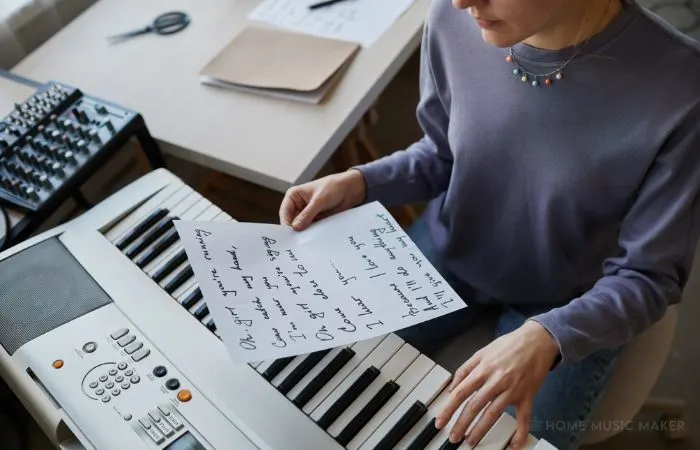
Make sure your verses and choruses work together to support the overall message of your song.
Of course, if you feel that by the end, the story has progressed in the verses, and the chorus narrative has yet to catch up, altering the lyrics for the last chorus to reflect this progression is common.
Overall, writing compelling Pop song lyrics takes practice and experimentation. Keep these tips in mind as you write, and don’t be afraid to try new things and take risks with your lyrics.
With time and effort, you can write lyrics that connect with your audience and make your song a hit.
READ NEXT:
Writing compelling lyrics usually comes from a very personal place. To learn how to do this, read our article on how to write a song from the heart.
Arrangement
When arranging a Pop song, there are a few key elements to keep in mind that will help you create a catchy, memorable track.
Intro And Outro
The intro and outro of your song are essential for setting the tone and leaving a lasting impression.
The intro should be attention-grabbing and draw the listener in. This is where you either get the listener to keep listening to the song or get them to skip it. Your music creates a sonic world, and the introduction is the doorway. Make it inviting.
The outro should provide a satisfying conclusion to the journey of the song that has taken place.
Suppose you’ve managed to keep the listener’s attention for the entire song. In that case, this is the finish line, and you must create a complimentary ending.
To create compelling intros and outros, consider using a hook or riff that appears throughout the song to tie everything together.
A fantastic intro that grabs your attention and pulls you in is in the song Attention by Charlie Puth. It’s just a fingerpicked guitar part and some vocal adlibs, but it sets the mood for the song so well and is the perfect entry to this sonic world we are about to embark on.
Verses
The verses of your song are typically less intense and full production-wise. It’s a place to sonically and lyrically set the scene further after the introduction.
Keep the arrangement simple and spacious, and consider adding variation in subsequent verses to keep the listener engaged. This can be a new melody on a different instrument, a percussive element, or anything that further builds the song.
Chorus
The chorus is the most memorable part of your song, so it’s essential to make it stand out.
Vocally, this is where you will have the most ear-catching performance of the song. You can also add harmonies or backing vocals to enhance the sound and strengthen the emotion of the chorus.
Production-wise, this is a much more sonically dense part of the song. It’s where the entire song lifts up to another level and pumps energy through the listener’s veins.
With each chorus, you can build up the arrangement further to help the song’s evolution until the climax of the last chorus.
Physical by Dua Lipa comes to mind when thinking of the perfect Pop chorus. It is huge in sound, the vocal melody is powerful and catchy, and it has so much energy.
Bridge
The bridge is an excellent opportunity to add contrast and variety to your song. Experiment with different chord progressions, instrumentation, or rhythms to create a unique sound.
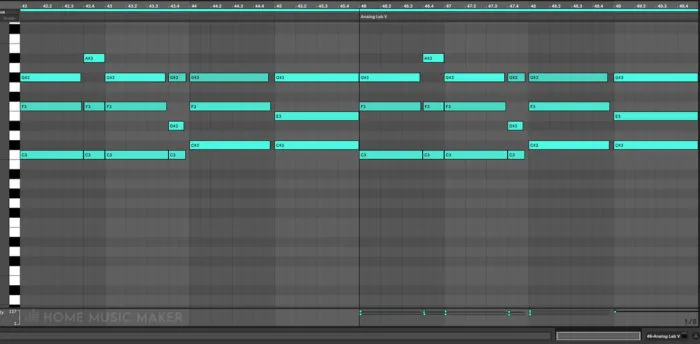
You can choose to have a much more stripped-back bridge, where it builds and builds to the last chorus. On the other hand, you can have a bridge that is just as rich in elements as the chorus but with a different instrument playing a solo.
The bridge should provide a break from the rest of the song before leading back into the chorus. It’s the last chance for the listener to breathe before the big and final moment.
Related Questions
What Are Some Common Themes In Pop Music?
– Love and relationships.
– Party and celebration.
– Empowerment and self-confidence.
– Heartbreak and loss.
What Is The Most Successful Pop Songs Of All Time?
– “I Will Always Love You” by Whitney Houston.
– “Candle In The Wind” by Elton John.
– “Billie Jean” by Michael Jackson.
How Can I Use Social Media To Promote My Pop Song?
– Create a social media presence and consistently post content.
– Use hashtags to help people discover you.
– Collaborate with other artists with a social media presence to share with fans.
– Run paid social media ads targeted at your demographic to find new followers.
How Can I Develop My Songwriting Skills?
– Analytically listen to music to build your knowledge of chord progressions, lyrics, melodies, and structure.
– Write music consistently. The more time you put in, the stronger that writing muscle will get.
– Collaborate with other songwriters to gain a new perspective and learn approaches to writing a song you never would have thought of.
– Read articles and watch interviews with your favorite songwriters, where they explain their process.
What Are Some Common Mistakes When Writing Pop Music?
– Lack of originality and authenticity.
– Overcomplicating the song.
– Focusing more on the music than the lyrics.
– Too much production to cover a less well-written song.
READ NEXT:
With all this information on how to write a Pop song, it can be difficult to know where to start. Check out our article on whether to write music or lyrics first.


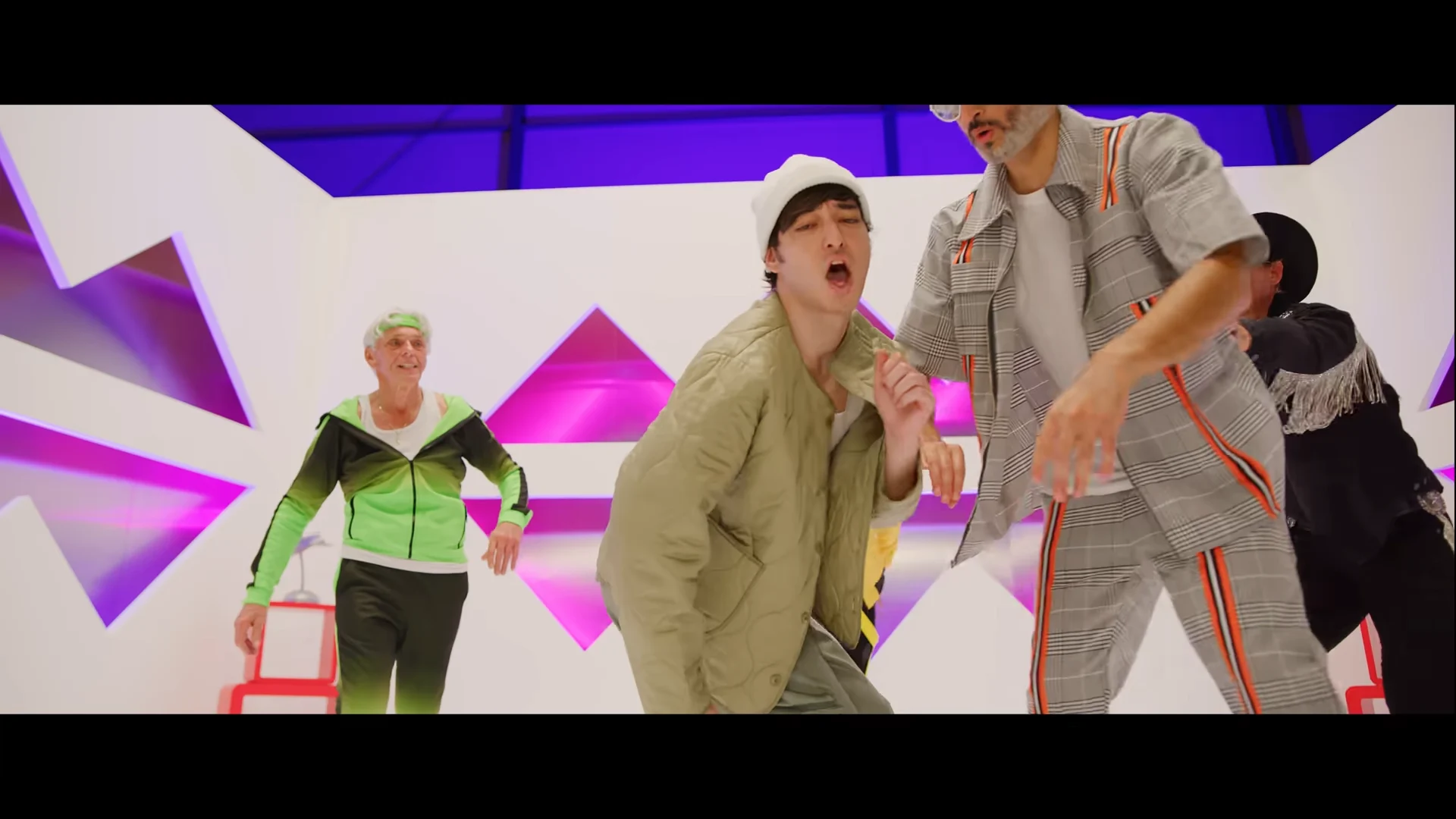
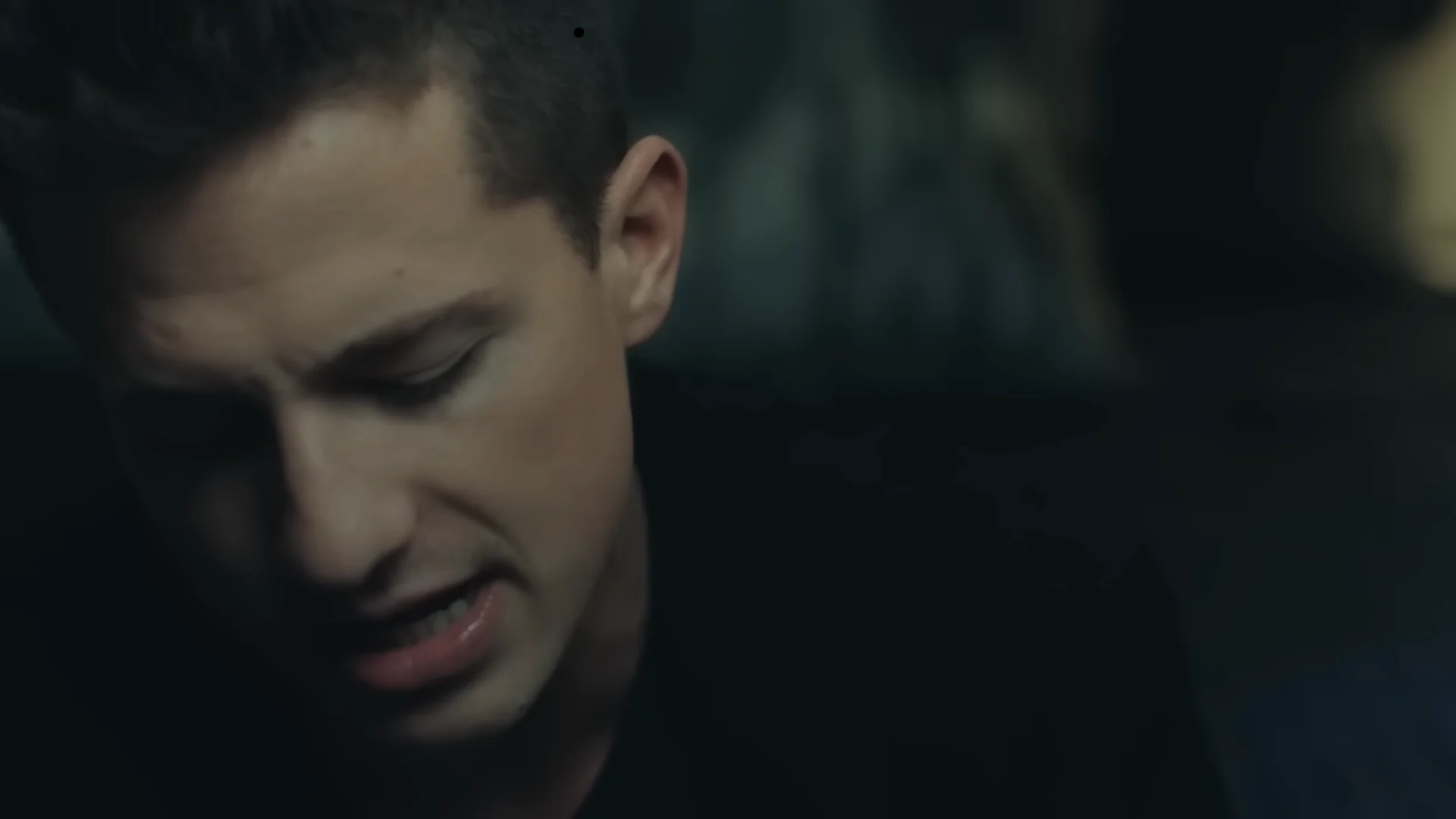
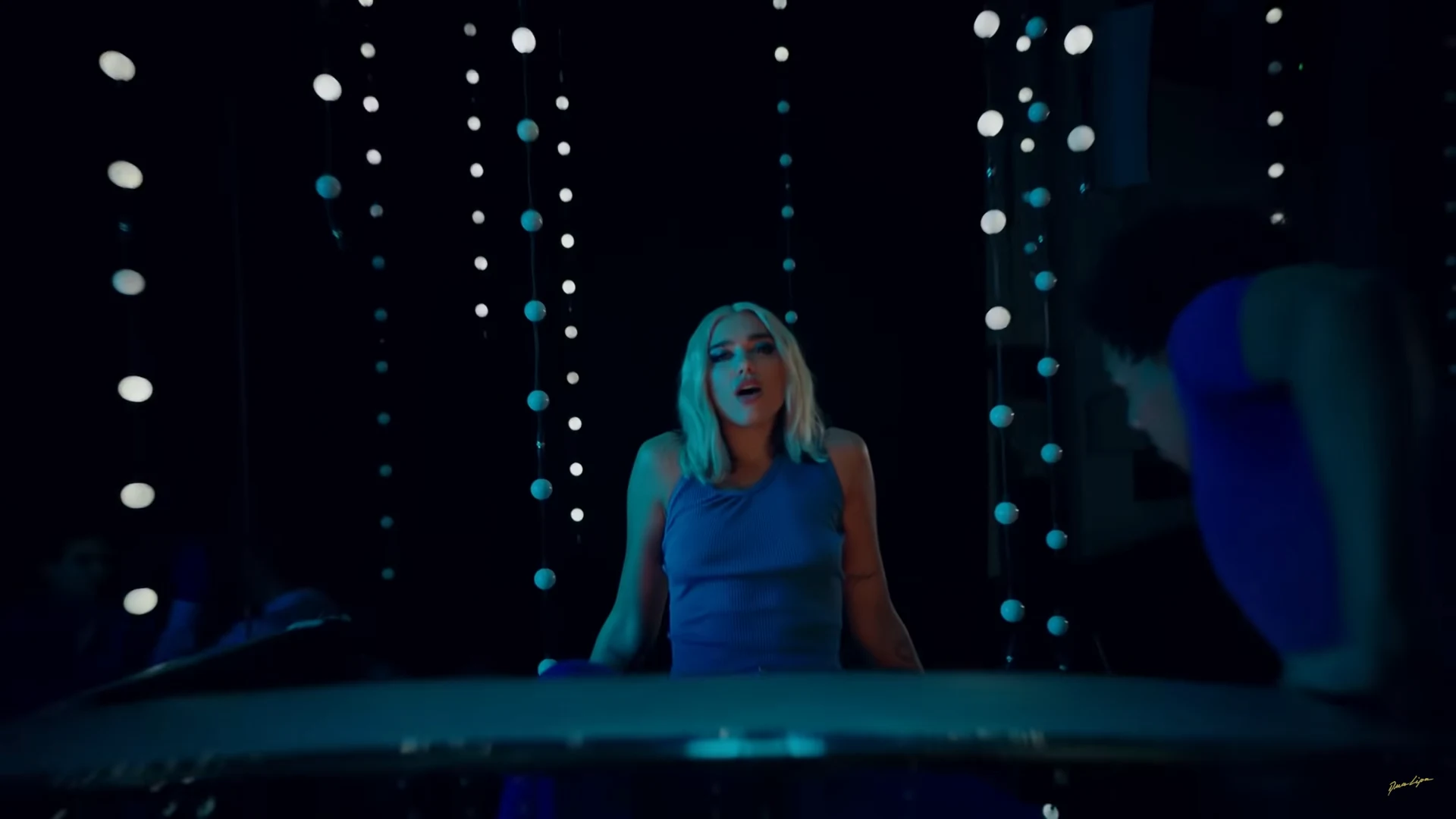
 Want to connect with other music producers for help and guidance?
Want to connect with other music producers for help and guidance?